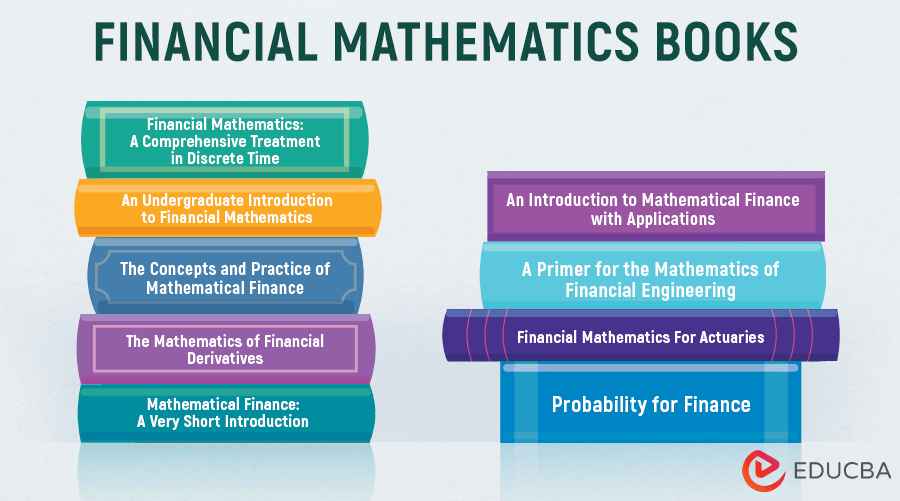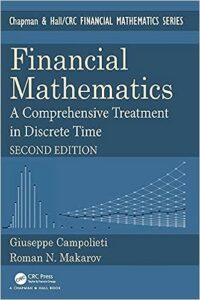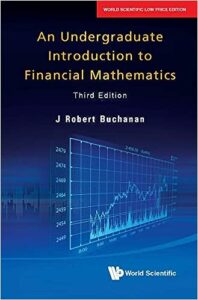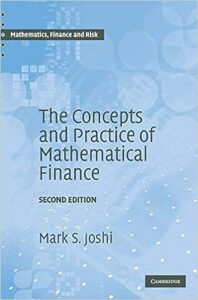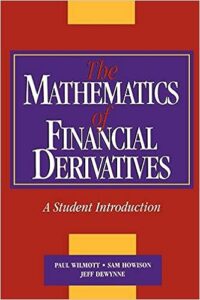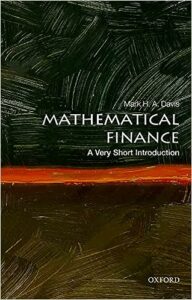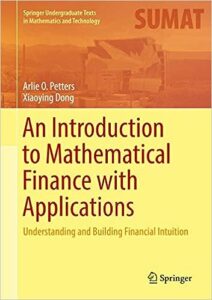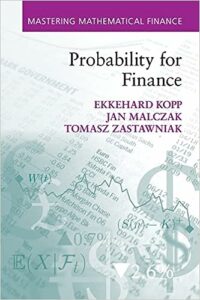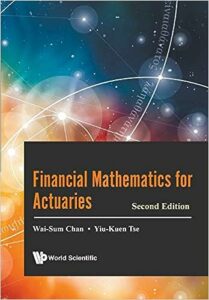Financial Mathematics Books – Introduction
Financial Mathematics books teach us about money management in the field of finance. From analyzing financial data to making crucial business financial decisions, these books simplify complex subjects into easy-to-understand language.
We have provided a list of the top 9 financial mathematics books to help the readers get a clear understanding of financial mathematics.
| # | Book | Author | Publishing Date | Rating |
| 1. | Financial Mathematics: A Comprehensive Treatment in Discrete Time | Giuseppe Campolieti, Roman N. Makarov | 2021 | Amazon: 4.0 |
| 2. | An Undergraduate Introduction to Financial Mathematics | J Robert Buchanan | 2022 | Amazon: 4.7 |
| 3. | The Concepts and Practice of Mathematical Finance | Mark S. Joshi | 2003 | Amazon: 4.4 Goodreads: 4.16 |
| 4. | The Mathematics of Financial Derivatives: A Student Introduction | Jeff Dewynne, Paul Wilmott, Sam Howison | 1995 | Amazon: 4.5
Goodreads: 3.64 |
| 5. | Mathematical Finance: A Very Short Introduction | Mark H.A. Davis | 2019 | Amazon: 4.3
Goodreads: 3.36 |
| 6. | An Introduction to Mathematical Finance with Applications: Understanding and Building Financial Intuition | Arlie O. Petters, Xiaoying Dong | 2016 | Amazon: 4.7 |
| 7. | Probability for Finance | Ekkehard Kopp, Jan Malczak, Tomasz Zastawniak | 2013 | Amazon: 3.9
Goodreads: 4.25 |
| 8. | Financial Mathematics For Actuaries | Wai-sum Chan, Yiu-kuen Tse | 2017 | Amazon: 4.1 |
| 9. | A Primer for the Mathematics of Financial Engineering | Dan Stefanica | 2011 | Amazon: 4.4
Goodreads: 4.18 |
Let us go through each book to help you select the right one for your needs.
Book #1: Financial Mathematics: A Comprehensive Treatment in Discrete Time
Authors: Giuseppe Campolieti, Roman N. Makarov
Get this book here.
Review:
For years, educators have relied on this book for academic studies. The author has enhanced the content with examples, problems, and solutions. Covering financial theory and mathematical methods, the book keeps you engaged from start to finish. It covers crucial topics such as time and financial models, foundational for pricing theory. One highlight is its multi-level problem-solving approach, connecting techniques with suitable pricing methods for different derivatives.
Key Points:
- The reader gains a deep understanding of discrete-time theory and various methods.
- In each chapter, there are examples and questions along with solutions provided.
- The book maintains a balance between financial, mathematical, and computational approaches.
Book #2: An Undergraduate Introduction to Financial Mathematics
Authors: J Robert Buchanan
Get this book here.
Review:
This book is a great choice for undergraduates looking to delve into financial mathematics and engineering. It’s particularly beneficial for those who have already taken a few calculus courses. It’s a recommended resource that bridges the gap between undergraduate and graduate-level mathematical finance studies. Notably, the author has revamped the portfolio optimization section, added depth to hedging techniques, and expanded on the Black-Scholes model.
Key Points:
- The reader will learn how to mathematically model financial derivative prices like bonds, options, and futures.
- The content covers the theory of interest, stochastic, statistical, and differential equations.
- However, the reader would have to be familiar with multivariable calculus.
Book #3: The Concepts and Practice of Mathematical Finance
Authors: Mark S. Joshi
Get this book here.
Review:
It is the right book for those beginning to practice mathematical finance. It discusses different types of models in depth, including their strengths and weaknesses. It also explains how to build these models and how different models work.
Key Points:
- Readers learn about the essential models in depth, including Black-Scholes, jump-diffusion, stochastic volatility, and variance gamma.
- The author discusses LIBOR thoroughly, being the industry standard.
- The book offers worked-out examples, exercises, and many computer projects.
Book #4: The Mathematics of Financial Derivatives: A Student Introduction
Authors: Jeff Dewynne, Paul Wilmott, Sam Howison
Get this book here.
Review:
The book addresses the practicality of mathematical methods used in today’s corporate and banking world. It provides the incentive for new mathematical models and methods. This book is especially useful for students as an introduction.
Key Points:
- It is a compilation of comprehensive differential equations with solutions.
- The book addresses today’s financial products, helping the reader to maintain pace with the real world.
- The book explains elementary calculus, algebra, and probability in-depth, so it is also appropriate for the reader with little or no calculus experience.
Book #5: Mathematical Finance: A Very Short Introduction
Authors: Mark H.A. Davis
Get this book here.
Review:
Mark Davis investigates the arbitrage theory that changed the Black-Scholes formula in 1973. The book shows how science and engineering graduates entered finance, bringing in new formulas and boosting the industry with their analysis and computational abilities.
Key Points:
- The author explains credit trading, interest rates, and fund and risk management.
- The book also has a survey addressing a persistent problem in mathematical finance.
- The author uses modern analysis and probability to explain the theory and the workings of pricing theory.
Book #6: An Introduction to Mathematical Finance with Applications: Understanding and Building Financial Intuition
Authors: Arlie O. Petters, Xiaoying Dong
Get this book here.
Review:
This textbook helps the reader to fill the gap between the theory and practice of financial mathematics. The book presents crucial financial tools and concepts for creating realistic models. It is loaded with examples and exercises with conceptual comprehension and usage.
Key Points:
- The book has divided and based the examples into three categories: conceptual, theoretical, and application.
- It offers a comprehensive introduction to basic mathematical finance and models, making it a good fit for physicists, engineers, and mathematicians.
- How the content is structured also lets instructors delve deeply into any topic.
Book #7: Probability for Finance
Authors: Ekkehard Kopp, Jan Malczak, Tomasz Zastawniak
Get this book here.
Review:
The author has written the book for instructors and students, focussing on the fundamentals of probabilistic concepts to understand financial market models. The writer has based the teaching on limit theory and used Financial models in its explanation.
Key Points:
- The book includes examples of financial market models.
- It also contains solved problems to enhance the reader’s grasp of the main concepts.
- Students can also test their comprehension through many exercises and worked-out concepts.
Book #8: Financial Mathematics For Actuaries
Authors: Yiu-Kuen Tse, Wai-Sum Chan
Get this book here.
Review:
The writers have compiled this book after intensive research on actuarial science, financial engineering, quantitative finance, and risk management. Each topic has intensive exercises at the end to test the student’s comprehension. The book is an asset to those pursuing actuarial science, financial markets, and financial mathematics.
Key Points:
- The book intensively covers interest rate theories and fixed-income pricing.
- The reader gets hands-on practice with Excel functions accompanied by a plethora of finance examples.
- The author discusses real-world financial market data like traded financial securities and historical Term structure.
Book #9: A Primer for the Mathematics of Financial Engineering
Authors: Dan Stefanica
Get the book here.
Review:
The book covers the most crucial mathematical and calculus foundations for using quantitative analysis to solve financial problems. It progresses from the fundamentals of calculus and probability to Taylor’s formula, multivariate calculus, and Lagrange multipliers. All mathematical formulae, theorems, and proofs are relatively simple and easy to understand.
Key Points:
- It offers several illustrations of practical financial applications, including Greeks and hedging, interest rates, bonds, and portfolio optimization.
- The book contains real-world issues prevalent in the financial sector with several examples as interview questions for quant finance positions.
- The reader finds it quite simple to implement by using pseudocodes, regardless of the programming language they choose to use.
Recommended Books
We trust this EDUCBA guide about the best 9 financial mathematics books was useful. For more details, EDUCBA suggests referring to these articles.
